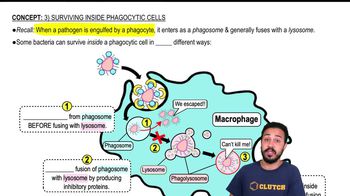Put the following in the correct order to describe the pattern of disease: period of convalescence, prodromal period, period of decline, incubation period, period of illness.
 Tortora 14th Edition
Tortora 14th Edition Ch. 14+15 - Principles of Disease and Epidemiology | Microbial Mechanisms of Pathogenicity
Ch. 14+15 - Principles of Disease and Epidemiology | Microbial Mechanisms of Pathogenicity Problem 15.10a
Problem 15.10aThe Opa gene is used to identify this endotoxin-producing bacterium that grows well in the high- CO₂ conditions inside phagocytes.
 Verified step by step guidance
Verified step by step guidance
Verified Solution
Key Concepts
Opa Gene

Endotoxin

Phagocyte Environment

Use the following information to answer questions 8–10.
A Maryland woman was hospitalized with dehydration. V. cholerae and Plesiomonas shigelloides were isolated from the patient, who had neither traveled outside the United States nor eaten raw shellfish during the preceding month. The patient had attended a party before hospitalization. Two other people at the party had acute diarrheal illness and elevated levels of serum antibodies against Vibrio. Everyone at the party ate crabs and rice pudding with coconut milk. Crabs left over from this party were served at a second party. One of the people at the second party had onset of mild diarrhea; specimens from of these people were negative for vibriocidal antibodies.
This is an example of
a. vehicle transmission.
b. airborne transmission.
c. transmission by fomites.
d. direct contact transmission.
e. healthcare-associated transmission.
This microbe is acquired by humans as infants and is essential for good health. Acquiring a closely related strain causes severe stomach cramps, bloody diarrhea, and vomiting. What is the microbe?
Which of the following statements is true?
a. The primary goal of a pathogen is to kill its host.
b. Evolution selects for the most virulent pathogens.
c. A successful pathogen doesn't kill its host before it is transmitted.
d. A successful pathogen never kills its host.
Compare pathogenicity with virulence.
What is the LD₅₀ for the bacterial toxin tested in the following example? <IMAGE>